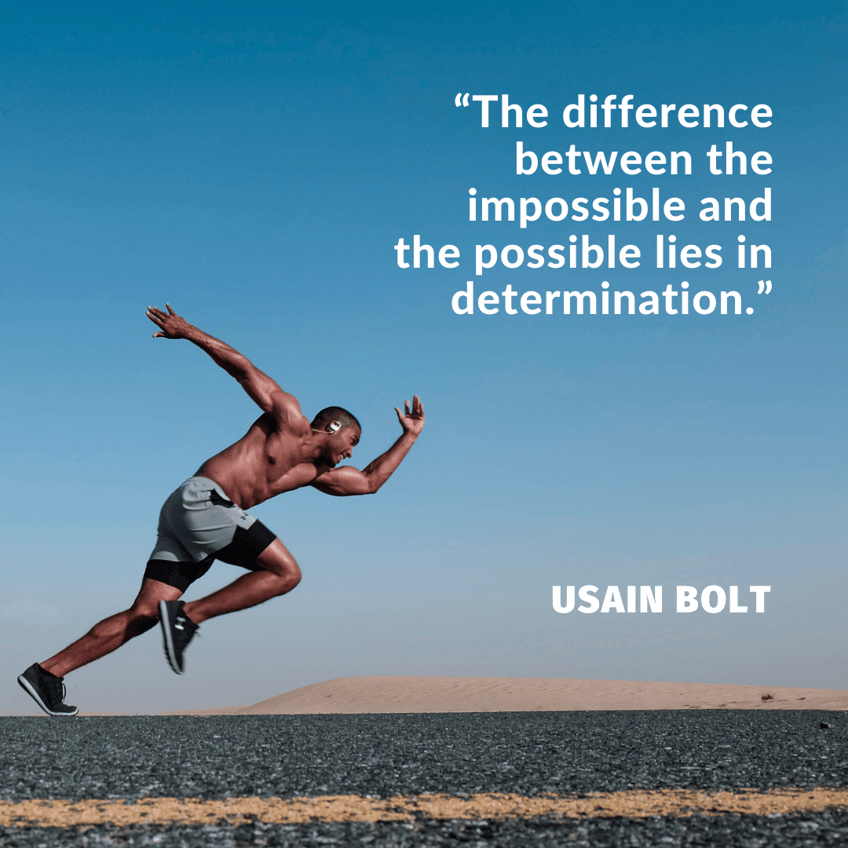“It takes 10 years to become an overnight success”. These were the words John McGrath once told me back in episode 122.
Those words stayed with me.
Meaningful growth doesn’t happen easily.
Forming habits that lead to massive results is simple ... but not easy. It takes consistency and practice.
When we see an artist burst onto the music scene with a massive hit, we often assume that song was their first foray into music (or close to it). This is likely because that’s the first song we’ve seen of theirs.
But the truth is, she's probably tried and failed hundreds of times before that hit song came to be (and crossed our path).
Chances are she's put a LOT more work into previous “hit” songs they published but those never made it onto the music scene. Never saw the light of day.
And this particular song you’ve just come across might've been the result of very little effort.
Perhaps she takes an average of 1 full week of effort to put out an average song, but this song barely took her a day.
Here's the thing:
This song may have taken her a day, but it still drew upon all the experience from the effort she put into all the preceding songs she’s released.
Introducing … the plateau of latent potential:
I first came across the term 'plateau of latent potential' when I read James Clear's book Atomic Habits.
James Clear and I had a good conversation about the principles in Atomic Habits so you might want to check it out at some point.
We often find that there's a gap between the results we expect to see, and the results we actually see. This is especially true when embarking on a new endeavor.
Let's take weight loss as an example. How often have you visited the gym for 7 days in a row and been disappointed with the results?
Even though you knew it wasn't going to help you lose weight in just a week, you've still felt disappointed on some level.
Because, on some level, you believe the effort you put into going to the gym for those 7 days in a row must translate to the desired result.
The truth is, results are happening ... they're just not visible to you .... yet!
James Clear and I discussed his approach to habit formation earlier on the Productive Insights podcast.
James explains that struggling to build a good habit is often because you haven't crossed the plateau ... yet.
And that word yet is a very important one.
If you want to achieve remarkable results, you need to understand that you need to be committed to your habit for a reasonable period of time.
James used the ice cube analogy to explain. Here's an excerpt from that conversation:
So this is an idea that I talk about in the book where you are working on a habit for a while and you just can’t seem to get the results that you want and you kind of feel stuck in the beginning. And the story that I like to use is imagine that you’re heating up an ice cube, you know, so you walk into a room, it’s cold, you can see your breath and the ice cubes sitting on the table and you start to heat it up slowly. One degree, two degrees, three degrees, so on your heating this room up, but still the ice cubes sitting there. And then at some point you make this little one degree shift. No different than all the ones that came before. But you hit the melting point, right? And this ice cube starts to melt. And you, when you hit that transition, what’s interesting about it is that the change that came right before the transition was the same thing as you were doing before, but you weren’t getting anything.
And often the process of building a better habit is kind of like that where you need to be putting work in for days and weeks and it feels like you’re not getting anywhere. It feels like you still have an ice cube sitting on the table, but if you’re willing to keep showing up and work through that plateau of latent potential, then eventually you’ll hit a phase transition. And I think that the core idea here is that if you’ve been working on a habit for three weeks or a month or six months or whatever it is, and you don’t have the results that you want, that work was not being wasted. It’s just being stored and you need to continue to show up so that you get to the phase transition and allow it to release. And that’s kind of the core idea of working through this plateau of latent potential. I love that luck was not being wasted. It was being stored.
The little things you do add up and those small improvements eventually lead to breakthrough moments where you see remarkable results.
When it comes to personal development, we tend to be focused on taking massive action for a short burst of time, and then we're disappointed because we didn't reach our end goal in a matter of days.
We often expect progress to be linear, but in my experience, it's anything but.
Progress comes in fits and starts. It doesn't happen in a linear fashion. We often feel like we're going in circles.
But with the benefit of hindsight, it's obvious that what seemed like "circles" were in fact, (ascending) spirals.

It's often months or years later that we realize the true potential of all the work we've put in. Take this blog for example. It was years and years before the blog achieved any visible traction.
But to make a meaningful difference, you'll need to cross the plateau of latent potential. And that usually means you'll have to deal with the "valley of disappointment" along the way.
This means you'll need to do the hard work of stepping out of your comfort zone on a daily basis before you see tangible results.
I like what James says about working with the understanding that your efforts aren't being "wasted" — it's being stored.
What is required is grit and perseverance. That's what gets you over that critical threshold.
Valley of disappointment
It's hard to develop new habits.
Why?
Because there's usually a considerable lag between our efforts (of performing the habit each day) and the results from that consistency.
Let's say you decide to go to the gym to get healthier and reduce body fat.
You go to the gym every day for 2 weeks and you don't see any meaningful changes in your body composition and your weight most likely stays the same.
At this point, you're not receiving any signals that your efforts are paying off in any way.
You're in the valley of disappointment.
The absence of visible results makes it harder to stick to the habit.
This is where most folks give up.
Here are 2 effective ways to address the valley of disappointment:
- Use the Paper-Clip Strategy — break the task into bite-sized chunks and focus on the process (not the outcome)
- Use the identity-based approach to habit creation — focus on being a writer, not writing every day
Growth mindset vs fixed mindset
In her book titled Mindset, Carole Dweck explains the difference between having a growth mindset vs a fixed mindset.
She explains that people with a growth mindset are more likely to enjoy a significant level of success.
People with a fixed mindset believe their abilities are static and they tend to have a fear of failure.
People with a growth mindset, on the other hand, tend to learn from criticism. They see an opportunity to improve where those with a fixed mindset shrink into their shell.
Ultimately a growth mindset is what leads to the most powerful outcomes over the long run.
While fear of failure is normal, and it's part of human nature, we need to consciously embrace new perspectives even if that means starting with small beginnings.
Developing a new habit is often the result of doing the right thing (not the comfortable thing) and applying consistent effort.
Success is a process, not a result. (The Usain Bolt story)

Most people see success as an "event". e.g. When Usain Bolt won the 100-meter sprint at the Beijing Olympics and set a new world record.
People saw that 100-meter sprint as his "success".
I think that's an unhelpful way of looking at success. It's also a tiny portion of the story and it's misleading.
Here's what most of us don't see when we think of Usain Bolt's "success" in smashing the world record:
- The fact that Usain had won the genetic lottery (most sprinters have a very high proportion of fast-twitch muscle fiber). According to Kumar Mehta, your genetics only make up about 50% of the way there (you'll still have to work incredibly hard and have what he calls enabling factors)
- That Usain recognized his natural strengths and decided to double down on them by working relentlessly for years. He would train for hours in the sweltering sun even when it was the last thing he wanted to do.
- Usain decided on his goal early in his life and then focused on that goal obsessively. This meant he gave up several other opportunities to pursue his dream of being the fastest man on earth.
Here are the most important things to understand:
- Going back to the first sentence in this blog post ... it takes 10 years to become an "overnight success" (often longer). When we see famous athletes or musicians burst onto the scene, we're seeing the result of years of consistent and sincere effort.
- Success is a process, not a result (though we often only notice the results of that process and call that success)
- Focus on the lead indicators (habits), not the lag indicators (results)

